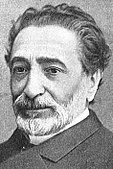| |||||||||||||||||||||||||||||
All 392 seats in the Congress of Deputies and 180 (of 360) seats in the Senate 197 seats needed for a majority in the Congress of Deputies | |||||||||||||||||||||||||||||
|---|---|---|---|---|---|---|---|---|---|---|---|---|---|---|---|---|---|---|---|---|---|---|---|---|---|---|---|---|---|
| Registered | 846,961 | ||||||||||||||||||||||||||||
| Turnout | 604,758 (71.4%) | ||||||||||||||||||||||||||||
| |||||||||||||||||||||||||||||
| |||||||||||||||||||||||||||||
The 1881 Spanish general election was held on Sunday, 21 August and on Friday, 2 September 1881, to elect the 2nd Restoration Cortes of the Kingdom of Spain. All 392 seats in the Congress of Deputies were up for election, as well as 180 of 360 seats in the Senate.[1]
Though formally competitive, the 1881 general election was held under the recently developed system of turno pacifico; in accordance with a semi-formal power-sharing arrangement brokered by Antonio Cánovas del Castillo, elections—under influence by machine bosses called caciques—served as a rubber stamp for a routine handover of power initiated by the King. The 1881 election, as expected, sanctioned the pre-arranged handover from the Conservatives to the newly created Liberal Fusionist Party. From 1881 until the end of the constitutional monarchy, the turno power-sharing plan would continue dominating the Spanish political landscape nearly uninterruptedly.
- ^ "Real decreto declarando disueltos el Congreso de los Diputados y la parte electiva del Senado" (PDF). Gaceta de Madrid (in Spanish) (177). Agencia Estatal Boletín Oficial del Estado: 871. 26 June 1881.


